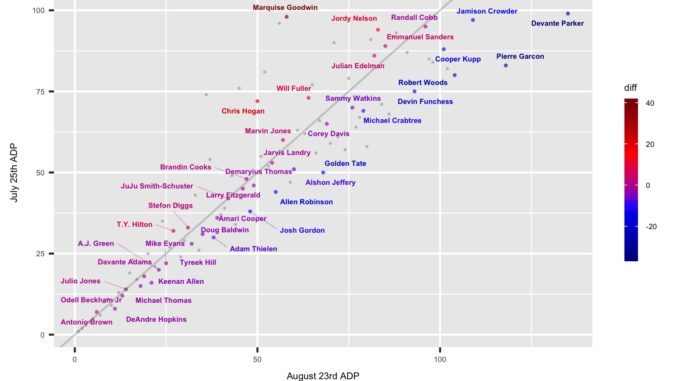
Fransburg – Recently, Immersion Commish Josh Hammond wowed the league by unveiling a huge, searchable data set. Player stats, draft picks, teams points scored, team wins, and on and on. It’s a truly impressive undertaking.
Unfortunately, it currently lacks context regarding owner performance.
During the dramatic (email) presentation, Hammond commented, “Early returns show that Enright and I are the best and the rest of you really need to get your shit together. It’s getting kind of boring, you know?” What’s boring is being forced to read through tired, blunt-force data that doesn’t even remotely tell the story of what it means to be a solid owner!
Early returns show that Enright and I are the best and the rest of you really need to get your shit together. It’s getting kind of boring, you know?
-Hammond

get these, do you?
Basically, Hammond would lead you to believe that because he and Enright have more total wins and total points, that they’re the best owners. Except…you and I BOTH know that the league has unique settings that make those instruments as useful as breaking out a fantasy magazine the day before the draft to set your draft board. Ammiright?!? (*snorts, pushes up glasses*).

Since 2017, our league has been intentionally divided into the Has and Has Nots of the Gold, Silver and Bronze Divisions. In its inaugural year, the historically best teams with the strongest rosters were put in the Gold and the very worst teams ditched into the Bronze. In Year 2 of this new setup, Gold teams were given more money ($400) than Silver teams ($375) and Bronze ($350) teams. So the best teams with the most money won more games and scored more points. Shocker!
So what to do?
I’ve created MY OWN rival data set encompassing the last three seasons, 2017-2019 when we had the new divisional set up. Could I have simply shared this with Hammond so he could easily improve his data set? Of course! But then I wouldn’t get to write this sweet burn article. Anyway, in this data set, the amount of money available to an owner and expected wins are added to the rudimentary factors like “total points scored” and “wins”. Additionally, I’ve included All-Play wins, which are of course a much better measure of a team’s overall strength. How many times does the 2nd highest scoring team lose? Or the 2nd lowest scoring team win? Lots of times, that’s how many.
Before you start exploring the data, here’s what I looked for:
Dollars per Win – It’s easier to score points when you have more money to pay for better players. The fewer dollars per point, the better.
Dollars per All-Play Win – How much does it cost you to win a game? The fewer dollars per win, the better.
Points per Dollar – Why did I annoyingly switch this up? Because there are a lot of points compared to dollars. Anyway, the more points per each dollar spent, the better.
Win Rate – number of actual wins divided by expected number of wins. The higher the percentage, the better.
Why does this matter? If you beat your expected number of wins, you’ve done great! Even if you didn’t win the championship or even advance out of your division. Why? Because there is SO MUCH luck in straight wins. Teams in the Silver and Bronze are expected to win fewer games every year than teams in the Gold.
Expected wins – See the document. Essentially, I argue that regardless of which division you’re in, you should win half of your games in division. Outside of division, Gold teams are expected to win all 4 games, Silver teams 2/4 games, and Bronze teams are expected to be swept by better teams.

You guys are not the best.
I made up stats that say so.
So who is ACTUALLY the best owner?
I’m writing the article, aren’t I? So I took every owner’s rank in each category (e.g., Dollars per win, Dollars per all play, Points per dollar, Win Rate) and added them together to create a Combined Rank Score. The lower the score the better. Over the past three years, Fransburg’s win rate is tops at 130% of expected. Fransburg has also scored the most points per dollar. Enright paces the field in Dollars per Win and Dollars per All-Play Win.
Not surprisingly, then, the only owner in the same tier of my awesomeness is Enright. It seems like you just can’t knock his performance over the years. In the tier below Jason and I are just about everyone else, including Hammond (6th of 12 ranked owners). The bottom tier is just Pershey and Rothfus, who really, really bottomed out in 2019. They were so bad. Like, wow.
So my official rankings are (combined rank score):
- Franssen (7)
- Enright (9)
- Marcot (17)
- Giorgianni (20)
- Jeppson (20)
- Hammond (21)
- T. Matuszak (26)
- Lindsay (31)
- Weldin/M. Matuszak (33)
- Garcia (37)
- Pershey (44)
- Rothfus (45)
This fucking guy. Posts a 3 year Win Rate of 89% (9th of 12 teams) and is talking about how we need to get our shit together. Child, please.”
-Slightly More Sophisticated Data
Oh right, I bet you want to see the data. Here’s the link to a google doc so you can judge for yourself!
Enjoy!
© 2020, Adam Franssen. All rights reserved.


Now I want a fantasy football magazine.